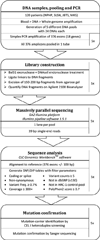Mutation analysis of 18 nephronophthisis associated ciliopathy disease genes using a DNA pooling and next generation sequencing strategy
- PMID: 21068128
- PMCID: PMC3913043
- DOI: 10.1136/jmg.2010.082552
Mutation analysis of 18 nephronophthisis associated ciliopathy disease genes using a DNA pooling and next generation sequencing strategy
Erratum in
-
Correction.J Med Genet. 2015 Dec;52(12):866. doi: 10.1136/jmg-2010-082552corr1. J Med Genet. 2015. PMID: 26603841 No abstract available.
Abstract
Background: Nephronophthisis associated ciliopathies (NPHP-AC) comprise a group of autosomal recessive cystic kidney diseases that includes nephronophthisis (NPHP), Senior-Loken syndrome (SLS), Joubert syndrome (JBTS), and Meckel-Gruber syndrome (MKS). To date, causative mutations in NPHP-AC have been described for 18 different genes, rendering mutation analysis tedious and expensive. To overcome the broad genetic locus heterogeneity, a strategy of DNA pooling with consecutive massively parallel resequencing (MPR) was devised.
Methods: In 120 patients with severe NPHP-AC phenotypes, five pools of genomic DNA with 24 patients each were prepared which were used as templates in order to PCR amplify all 376 exons of 18 NPHP-AC genes (NPHP1, INVS, NPHP3, NPHP4, IQCB1, CEP290, GLIS2, RPGRIP1L, NEK8, TMEM67, INPP5E, TMEM216, AHI1, ARL13B, CC2D2A, TTC21B, MKS1, and XPNPEP3). PCR products were then subjected to MPR on an Illumina Genome-Analyser and mutations were subsequently assigned to their respective mutation carrier via CEL I endonuclease based heteroduplex screening and confirmed by Sanger sequencing.
Results: For proof of principle, DNA from patients with known mutations was used and detection of 22 out of 24 different alleles (92% sensitivity) was demonstrated. MPR led to the molecular diagnosis in 30/120 patients (25%) and 54 pathogenic mutations (27 novel) were identified in seven different NPHP-AC genes. Additionally, in 24 patients only single heterozygous variants of unknown significance were found.
Conclusions: The combined approach of DNA pooling followed by MPR strongly facilitates mutation analysis in broadly heterogeneous single gene disorders. The lack of mutations in 75% of patients in this cohort indicates further extensive heterogeneity in NPHP-AC.
Figures




References
-
- Hildebrandt F, Zhou W. Nephronophthisis-associated ciliopathies. J Am Soc Nephrol. 2007;18:1855–1871. - PubMed
-
- Hildebrandt F, Otto E. Cilia and centrosomes: a unifying pathogenic concept for cystic kidney disease? Nat Rev Genet. 2005;6:928–940. - PubMed
-
- Hildebrandt F, Otto E, Rensing C, Nothwang HG, Vollmer M, Adolphs J, Hanusch H, Brandis M, et al. A novel gene encoding an SH3 domain protein is mutated in nephronophthisis type 1. Nat Genet. 1997;17:149–153. - PubMed
-
- Otto E, Hoefele J, Ruf R, Mueller AM, Hiller KS, Wolf MT, Schuermann MJ, Becker A, Birkenhager R, Sudbrak R, Hennies HC, Nurnberg P, Hildebrandt F. A gene mutated in nephronophthisis and retinitis pigmentosa encodes a novel protein, nephroretinin, conserved in evolution. Am J Hum Genet. 2002;71:1161–1167. - PMC - PubMed
Publication types
MeSH terms
Grants and funding
LinkOut - more resources
Full Text Sources
Other Literature Sources
Molecular Biology Databases
